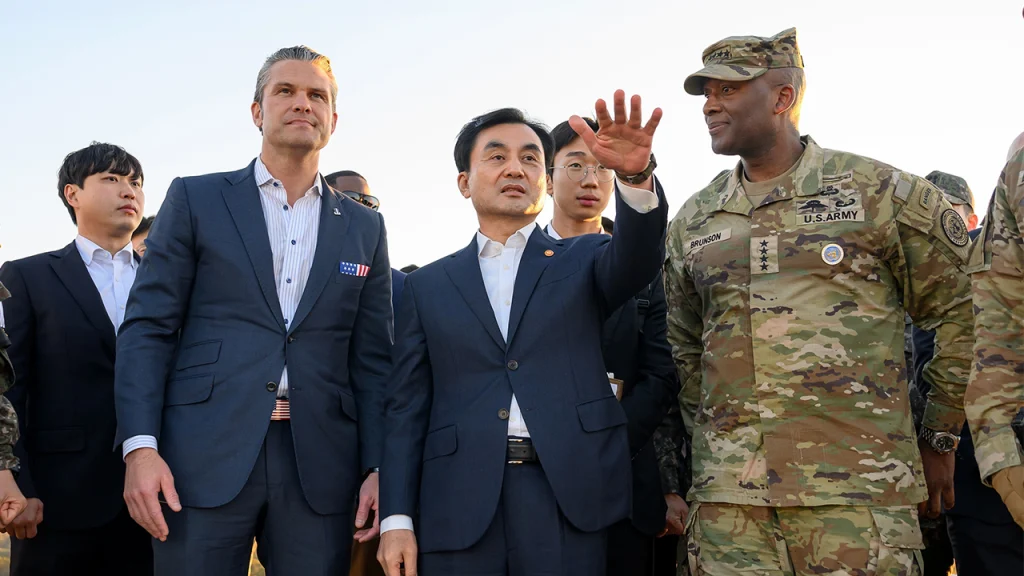North Korea Fires Ballistic Missile Amid Heightened Peninsula Tensions
North Korea launched a short-range ballistic missile off its eastern coast on Friday, just days after U.S. Defense Secretary Pete Hegseth completed his diplomatic visit to South Korea. According to South Korea’s Joint Chiefs of Staff, the missile was fired from an inland area near the western county of Taekwan and traveled approximately 435 miles toward the East Sea. Military officials in both Seoul and Tokyo confirmed the launch, which represents the latest in a series of provocative weapons tests that have intensified regional tensions. South Korean military authorities noted they had detected preparation signs before the launch and continue monitoring the area for additional activity, highlighting their ongoing vigilance against North Korean threats. Japanese Prime Minister Sanae Takaichi confirmed that no injuries or damage resulted from the missile test, though the incident has further strained already tense relations in the region.
The timing of this missile launch appears deliberately provocative, coming shortly after Secretary Hegseth’s three-day diplomatic mission to South Korea that concluded on November 4th. During his visit, Hegseth held security talks with South Korean Defense Minister Ahn Gyu-back in Seoul, where he expressed being “greatly encouraged” by Seoul’s commitment to increasing defense spending and investing more heavily in building its military capabilities. Both allies agreed that these investments would strengthen South Korea’s position to take a more prominent role in conventional deterrence against North Korean aggression. This missile test seems designed to undermine these diplomatic efforts and demonstrate Pyongyang’s continued defiance of international pressure. The launch follows what Reuters described as several recent missile tests by North Korea, including systems the country claims are “cutting-edge” strategic weapons, indicating an accelerating weapons development program despite international sanctions.
Secretary Hegseth’s visit had emphasized the Trump administration’s commitment to strengthening the U.S.-South Korea alliance while encouraging Seoul to assume greater responsibility for its own defense. Notably, Hegseth highlighted President Trump’s support for South Korea’s plans to build nuclear-powered submarines, explaining that this backing stems from Trump’s desire to have “strong allies.” “Because Korea has been a model ally, he’s open to opportunities like that, that ensure they have the best capabilities in their own defense and alongside us as allies,” Hegseth stated during his visit. This position represents a strategic shift that acknowledges South Korea’s growing military capabilities while maintaining the core alliance structure. The timing of North Korea’s missile launch appears calculated to test this evolving defense relationship and perhaps exploit any perceived weaknesses or transitions in the alliance’s approach to regional security.
The missile launch underscores the delicate security dynamics on the Korean Peninsula, where approximately 28,500 U.S. troops remain stationed as part of a longstanding security commitment. During his discussions in Seoul, Secretary Hegseth was questioned about whether these U.S. forces might potentially be deployed in conflicts beyond the Korean Peninsula, particularly regarding potential conflicts with China. While affirming that deterring nuclear-armed North Korea remains the alliance’s primary objective, Hegseth acknowledged that “flexibility for regional contingency is something we would take a look at,” suggesting a potential broader regional security role for the alliance. This statement takes on added significance given the timing of North Korea’s latest missile test, which seems designed to reassert Pyongyang’s relevance in the regional security equation and potentially complicate U.S.-South Korean defense coordination at a time when both allies are discussing evolving security arrangements.
The United States and South Korea have maintained close military coordination as Pyongyang has accelerated its weapons testing program in recent years. North Korea’s continued missile launches and weapons development pose significant challenges to regional stability and international non-proliferation efforts. Despite numerous rounds of international sanctions and diplomatic initiatives aimed at curtailing North Korea’s nuclear ambitions, the country has persisted in developing and testing increasingly sophisticated missile systems. Friday’s launch represents another example of North Korea’s strategy of using provocative actions to gain leverage and international attention. Both Seoul and Tokyo indicated they are analyzing the latest launch in coordination with the United States, highlighting the trilateral cooperation that has become increasingly important in responding to North Korean provocations. This coordinated response reflects the shared security concerns that have drawn these three countries closer together despite occasional diplomatic tensions.
The current situation illustrates the ongoing security challenges facing the Korean Peninsula and broader Northeast Asian region. North Korea’s persistent missile tests and nuclear ambitions remain a central security concern for South Korea, Japan, and the United States, requiring continued vigilance and coordination. Secretary Hegseth’s recent visit to Seoul aimed to reaffirm the U.S. commitment to its South Korean alliance while encouraging Seoul to take on greater responsibility for conventional deterrence against North Korean threats. This evolving security partnership faces constant testing from Pyongyang, as evidenced by Friday’s missile launch. As both Washington and Seoul work to strengthen their alliance and deterrence capabilities, North Korea continues its pattern of provocative actions designed to demonstrate its military capabilities and gain international leverage. The missile launch serves as a stark reminder of the fragile security situation on the Korean Peninsula and the persistent challenges facing international efforts to address North Korea’s weapons programs through diplomacy and sanctions.


